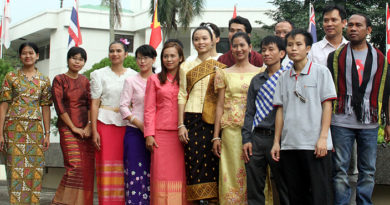Bangkok: Enhancing office buildings through placemaking
Young people take a selfie in front of a shopping mall in Bangkok. Learning what millennials want for their workplace would give employers an advantage in attracting the young talent. (Bangkok Post file photo).
As the role and importance of the workplace move up the corporate agenda, and as companies compete to attract the best talent, the trend for “placemaking” has become a more critical factor in the design and development of offices.
CBRE Real Estate Research defines placemaking as “integrating design, amenity, and community to create a unique space where people want to be”. This approach has until recently been confined to retail landlords that have been responding to the challenges posed by e-commerce to create compelling reasons to attract shoppers to spend time in their malls.
The same approach is now being applied to office developments. Not only have tenants been focusing on the number of square metres per employee, rental, and basic functionality; they have also increased their focus on wellness, food and beverages, end-of-trip facilities, and day-care. They, therefore, demand offices with a placemaking feel.
Millennials, the generation defined as those reaching adulthood in the 21st century, will account for 35% of the working population in the Asia Pacific Region by 2020, according to the United Nations. Businesses seeking to attract the best millennial talent will need to ensure they provide a workplace that satisfies their high expectations.
CBRE’s Millennials: Shaping the Future of Real Estate 2016 survey, found that millennials view their office and its immediate surroundings as not just a place of work, but also as a community where they can relax, socialise, and engage in other activities; all of which can increase their productivity and job satisfaction. This is also a key consideration when deciding who they want to work for.
Employers are already changing the way they design the interiors of their offices to increase collaboration, interaction, and employee satisfaction. It is now the turn of landlords to ensure that the interior design of new office developments matches the requirements of tenants and their employees.
Amenities are a critical component of placemaking in offices and can play a key role in helping companies attract and retain employees.
CBRE Research Team’s Asia Pacific 2017 Occupier Survey Report showed that there is a growing trend among multinationals to provide greater amenities for their staff within the premises, such as coffee bars and canteens. As the “wellness concept” gains traction, some large-space users are even providing in-house fitness centres.
Around 30% of multinationals surveyed by CBRE run wellness programmes and another 30% intend to do so in the near future.
Other tenants have identified day-care centres as the top facility they would like to introduce in the future.
Companies in Australia and Japan are especially keen on day-care centres as a means to attract and retain women in their workforce.
Australia is seeing strong demand for “end-of-trip” facilities such as showers and bike racks for employees who cycle or run to work.
While providing amenities can enhance the workplace, they are only truly effective if employees actually use them. As millennials grow to become the largest generation in the workforce, companies and landlords need to pay attention to their preferences.
Each country’s needs and regulations are different, so while end-of-trip facilities are popular in Australia, the climate and road safety in Bangkok could mean that only a few would cycle to work.
While many companies want to provide amenities within their premises, high real estate costs and limited space restrict their capacity to do so. Tenants rely on landlords to provide these facilities by leasing space to restaurants and fitness centres.
Developers need to understand their occupiers’ requirements so that they can incorporate their needs in new office designs.
This will mean that developers will have to communicate with tenants far more about the tenants’ needs, rather than just about commercial terms and the utility of the building.
How well a building matches the tenants’ requirements will determine rents achieved and occupancy in the future.
Nithipat Tongpun is executive director, head of office services at CBRE Thailand, and Thatchanan Siddhijai is manager at CBRE Research & Consulting, CBRE Thailand. They can be reached at [email protected] Facebook: CBRE.Thailand Twitter: @CBREThailand LinkedIn: CBRE Thailand website: www.cbre.co.th
Courtesy: Bangkok Post | Published: 04 Oct 2017 | WRITER: Nithipat Tongpun and Thatchanan Siddhijai
<>
[email protected] |For comments,









